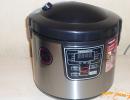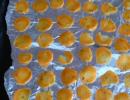What can cause acetone in a child?
A child’s body is constantly improving and developing, so at the initial stage of life, organs may not function fully. This often leads to the problem of impaired fat metabolism, which causes the accumulation of acetone in children. This disease causes nausea and vomiting, and also leads to a decrease in the vital activity of babies.
What is acetonemia?
All nutrients entering the body are processed and broken down into individual components, each of which is required for normal life. The liver produces ketone bodies necessary for energy metabolism, but due to imperfections in the body's systems, they can accumulate in the blood in a much larger volume than required. The predominance of ketone bodies - acetone and acids - causes intoxication, so the baby feels nausea and weakness, often vomits, and in this situation a high temperature may be observed.
The cause of the acetonemic crisis can be the following factors:
- poor nutrition– since the ability to digest fatty foods in children is quite low, even a single intake of too fatty foods can lead to the accumulation of acetone in the baby’s blood and urine;
- malnutrition– can also cause an acetonemic symptom, since due to a lack of nutritional components, the body begins to use its internal reserves and spends more energy than necessary, which means there is no strength left to process and eliminate toxins. Harmful components accumulate in the body, causing a vomiting reaction;
- past illnesses- for example, diabetes, intestinal infections, concussions and tumors - can lead to periodic accumulation of acetone in babies. However, most often this disease affects children suffering from neuro-arthritic diathesis, i.e., a chronic metabolic disorder.
The accumulation of acetone in the blood can occur regularly, or it can occur suddenly. This phenomenon can manifest itself from the very first year of life and continue until the child reaches 12-13 years of age. Around this time, the internal systems are already fully formed and functioning in full, so ketone bodies will no longer accumulate in dangerous quantities.

How to determine the presence of acetone in the body of children?
Like any other disease, acetonemia should be eradicated in the initial minutes of its manifestation, since the prolonged presence of toxins has a detrimental effect on the body. The following symptoms are considered sure signs of the presence of acetone in the baby’s blood:
- lethargy, drowsiness and weakness;
- lack of appetite;
- headache;
- pain attacks in the abdominal area;
- nausea;
- the smell of acetone from the mouth and the presence of a similar odor in the urine;
- increase in body temperature to 39 degrees.
The manifestation of such symptoms in children ultimately leads to vomiting, and it can be either one-time or prolonged (depending on the amount of toxins in the body).
It should be noted that the above symptoms can also occur as a result of pathogenic bacteria entering the body, therefore, for the final diagnosis of acetonemia, you can use special pharmacy tests. You can purchase test strips for the presence of acetone in urine without a prescription; they are small oblong strips of litmus paper. At the end of each product there is an indicator treated with reagents that appear under the influence of acetone. Place the end with the indicator in fresh urine (up to 3 hours) and wait about a minute for the reaction to complete. The final result is compared with the indicators in the instructions:
- “+/-” or “+” (from 0.5 to 1.5 mmol/l) – a slight excess of the level of acetone in the urine, at which treatment at home is possible;
- “++” (4 mmol/l) – average level of toxins in the urine, a visit to the hospital is not necessary, however, if your health worsens, consulting a doctor will not hurt;
- “+++” (10 mmol/l) – a high level of acetone in the urine, which requires rapid cleansing of the body, which is only possible in hospital treatment.
In some tests, the indicators differ slightly from the standard ones, so it is best to rely on the original interpretation of the results in the proprietary instructions.

What to do if an acetone crisis occurs?
In the event of a periodic occurrence of such an illness in children, the actions of parents should be aimed at preventing vomiting and stopping the disorder in the initial stage. First of all, you should check the level of acetone in the urine using a special pharmacy test.
- At the first signs of the disease, children should be provided with plenty of fluids; the best option would be alkaline compounds - still mineral water, lemon tea, pharmaceutical "Regidron", etc. This will help remove excess toxins from the blood, but you need to drink small doses very often (about every 10-15 minutes, 2-3 spoons each), since a large one-time volume will provoke repeated vomiting. For very young children, you can use a pipette or syringe to inject liquid every five minutes.
- If, along with a general deterioration in health, the baby complains of abdominal pain, you can offer him one of the safe sorbents - Smecta, Enterosgel, etc.
- When, along with other symptoms, a high temperature is observed, it is recommended to give children a cleansing enema; it will help remove excess harmful substances and significantly reduce the temperature. For this procedure, you can use regular cool water or a weak sodium solution (one spoon of soda per glass of warm water).
When acetone in a child does not stabilize for a long time, you should seek the help of a doctor. In this situation, the optimal choice would be to switch to intravenous fluid administration; in weak forms, injections are indicated, and in advanced cases, droppers.

Measures to prevent the appearance of acetone in the body of children
To help a fragile body fight harmful phenomena, you should properly organize the baby’s lifestyle, which our recommendations will help you with:
- The basis of good health is a healthy lifestyle, which requires regular walks in the fresh air, active games and sports exercises. In addition, water treatments will not hurt - daily baths, cool rubdowns, etc.;
- high-quality and complete sleep - a rested body works as actively as possible, so the accumulation of acetone is less likely;
- good nutrition – children’s diets must include vegetables and fruits, cereals and dairy products, while fried and fatty foods should be avoided;
- prevention of infectious diseases - timely implementation of preventive vaccinations and strengthening the immunity of children with the help of vitamin complexes.






